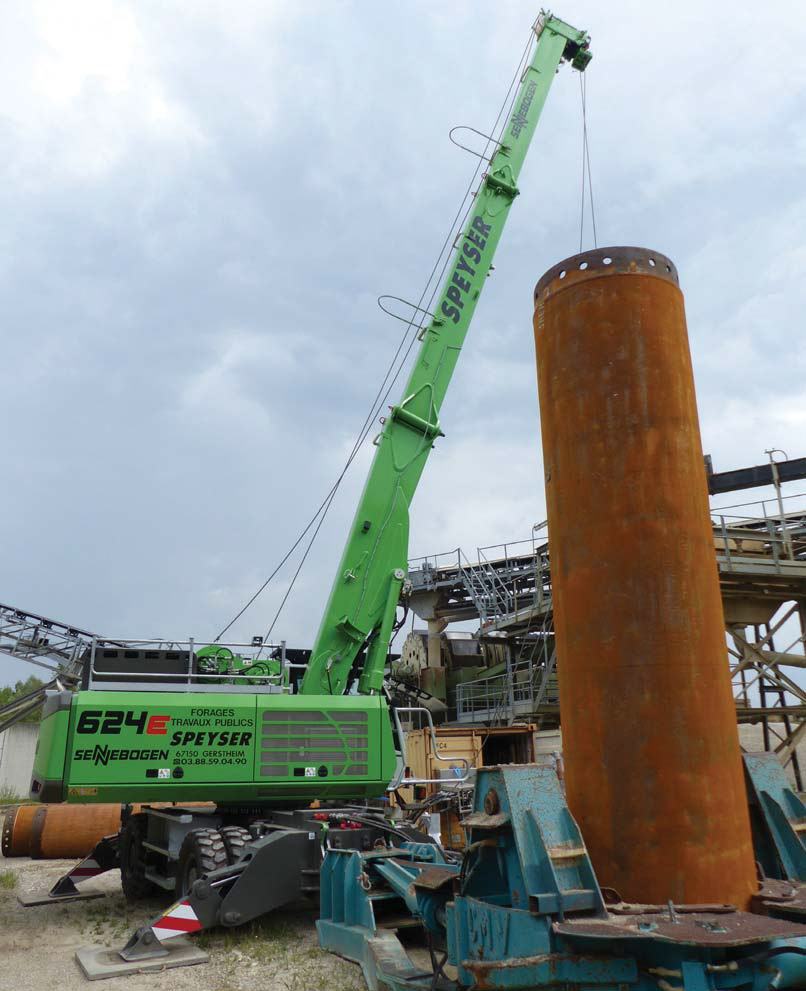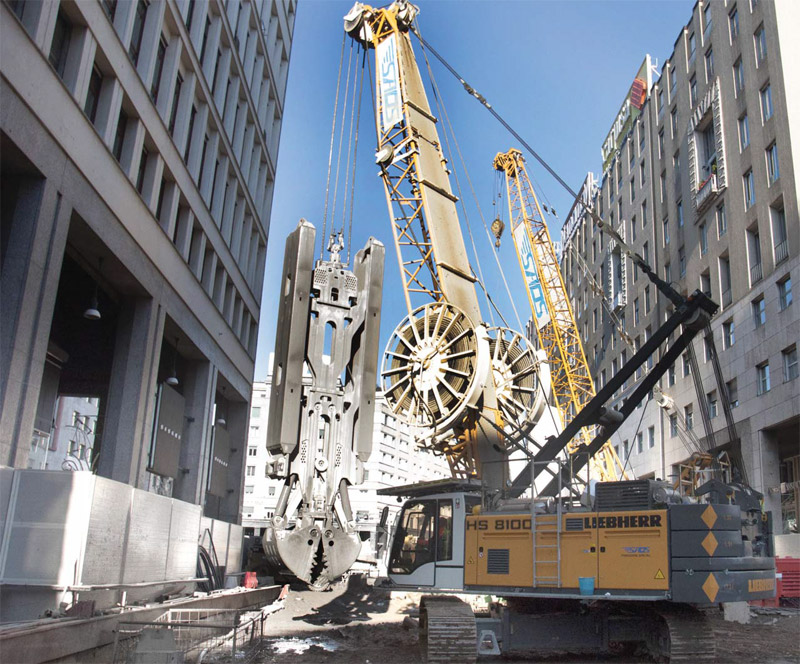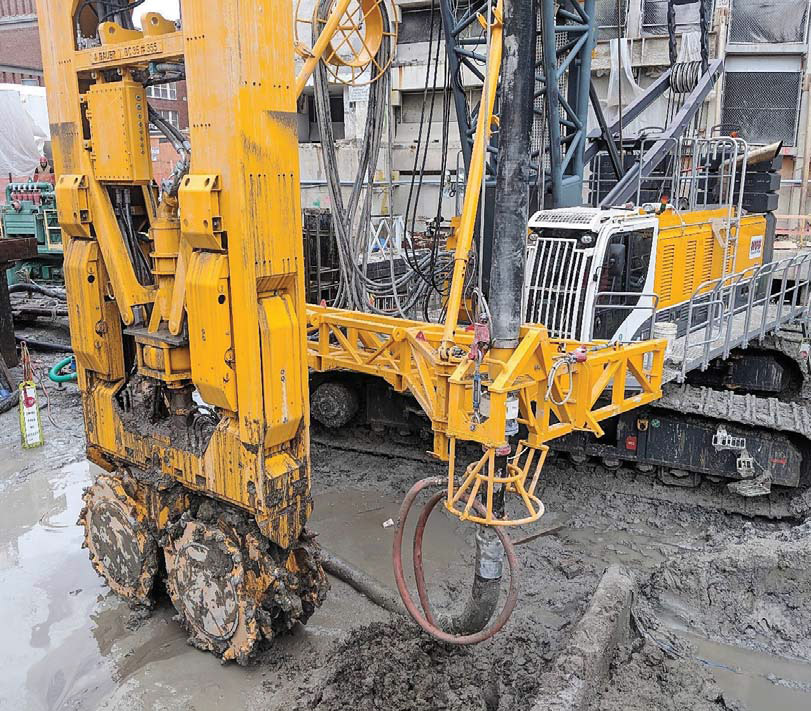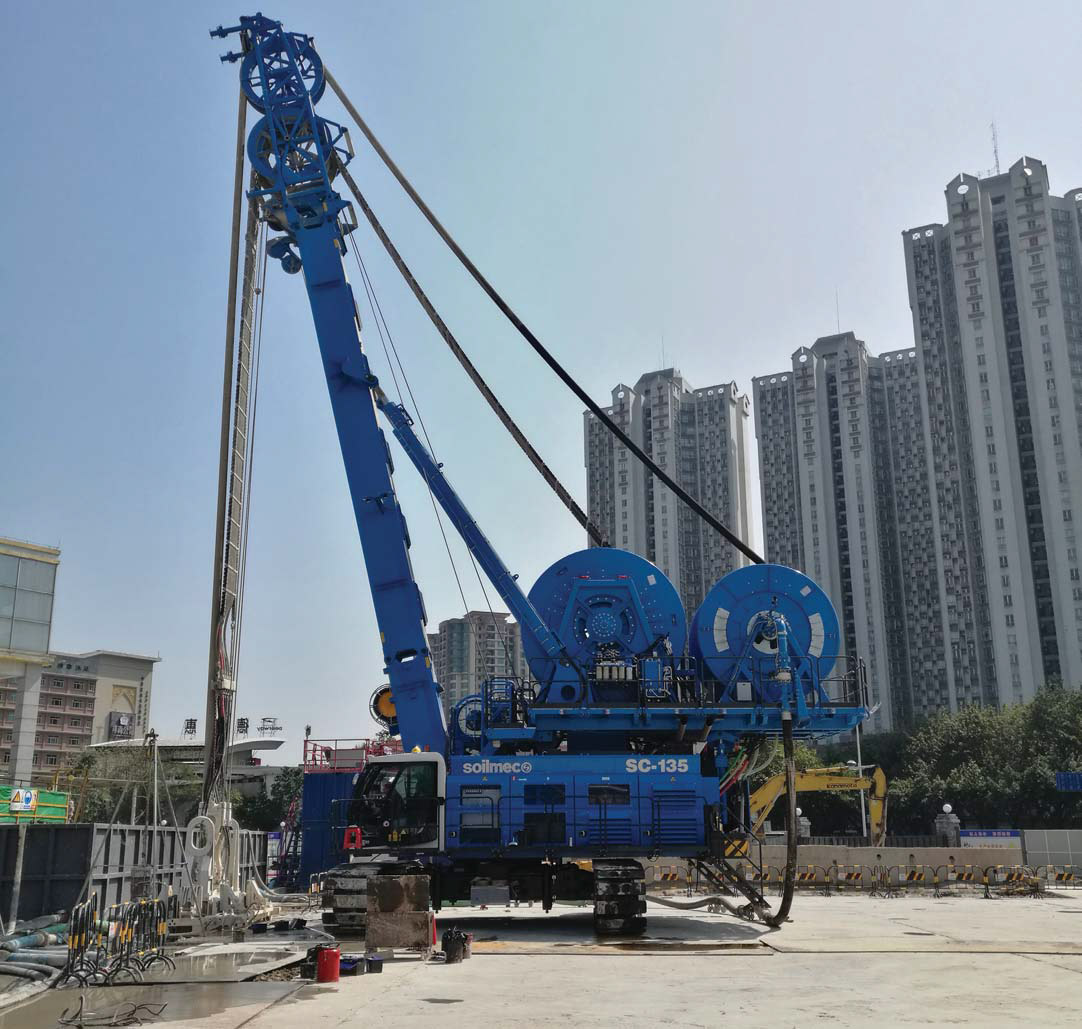Truly heavy
13 November 2018In the first of two articles, Stuart Anderson, president of Chortsey Barr, looks at the development of heavy duty crawlers. In part two, next month, he looks in more detail at the Japanese industry, and a variety of attachments and applications for these machines
The term ‘heavy duty’ has been bandied about for decades. It’s been used to describe everything from 4x4s to bulldozers.
To many it’s become just another advertising buzzword. However, while not many cranes are named ‘Heavy Duty’, in most cases where it is used, it has real meaning.
As far as I can discover the first crane model to be officially thus named was the “Heavy Duty” version of the Ruston-Bucyrus 22-RB. An astonishing 10,245 22-RBs were made in Lincoln, England between 1950 and 1985: this was almost certainly the most successful crawler excavator/crane ever produced.
In 1957, R-B introduced a Heavy Duty version of the 22-RB featuring extra counterweight and lifting capacity boosted to 12 long-tons (12,176kgs). As market demand for more specialized crawler cranes increased during the 1960s, R-B developed Heavy Duty versions of its popular larger-sized machines – the 30-RB SII HD, 38-RB SII HD and 61-RB SII HD. Introduced in 1969, these cranes featured larger-dimensioned undercarriages and heavier counterweights to boost capacities to 30, 40 and 60 long-tons (30.44, 40.59 and 60.88-tonnes) respectively.
Since then the term has been employed quite-sparingly. However, over time it has come to imply that a ‘Heavy Duty’ crane is of a stronger structural construction and more powerful specification than ‘standard’ models, rather than necessarily offering greater lifting capacity. Indeed, lifting capacity and boom length is often compromised because the booms of these HD machines are constructed of thicker and therefore heavier tubes. Because the term ‘heavy duty’ has become so ubiquitous in everyday life, crane manufacturers sometimes relent from its use, presumably seeing it as a worn-out advertising slogan. But the fact is that there is a distinct variety of crawler crane that merits the term.
These ‘heavy duty’ cranes are heavier and more powerful that regular ‘lift cranes’. They are engineered to take on the really tough tasks, beyond simple lifting work, and designed for the severe rigors of foundation work and duty cycle grab or dragline.
In the old days when mechanical crawler excavator/cranes ‘ruled’, it was a given that all machines were built and equipped for the most-arduous tasks—excavating, piling or lifting. But that changed with the emergence of hydraulic lattice boom crawler cranes around 1970. Mechanical crawler cranes were never especially popular with crane rental companies for obvious reasons - they were heavy and difficult to transport; slow and difficult to assemble and dismantle, and heavy and noisy to operate.
Mechanical crawler cranes were widely seen as a machine for jobs of long-duration and therefore were mostly purchased by construction contractors, public works departments, port authorities, etc.
One of the prime aims of the designers of the new hydraulic crawler cranes was to overcome the weaknesses of the mechanical machines. What’s more, the fastgrowing crane rental industry was taking an ever-bigger share of the market and rental companies wanted cranes that were more-transportable, faster and easier to operate than the heavy, old mechanical cranes (known as friction cranes in North America).
For the designers of hydraulic cranes there were also serious technical hurdles to be overcome. Hydraulics were still in their relative infancy—the power output of components was limited, oil leaks were abundant and reliability poor.
For crane design engineers, the specific challenges included how to hydraulically-replicate the powerful hoist line pulls, strong swing torque and gravity ‘free fall’ of the mechanical cranes in service worldwide in their tens of thousands and at the same time keep their hydraulic systems and brakes from overheating.
While Sennebogen pioneered the first-fully hydraulic crawler excavator/ crane in 1969, much of the running in the early days of hydraulic crawler cranes was made by the Japanese manufacturers. Hitachi particularly paid special-attention to foundation applications, establishing a manufacturing subsidiary in Oosterhout, the Netherlands in 1974 that, under the inspired leadership of Bert van Dorth, proved highly-successful in selling both straight crawler lift cranes and locally adapting them to a high-level of sophistication for piling duties. These Hitachi hydraulic crawler cranes, generally in the 35–100t classes, became a major factor in the European market from the late 1970s until well into the 1990s.
Sumitomo also achieved widespread success in Europe, thanks again to the efforts of their Dutch representative – this time the famous Doornbos Company. Later, in the US, it was Sumitomo’s affiliate, FMC-Link-Belt, that changed the landscape with its ConExpo 1987 launch of the LS 138H and LS 218H fully hydraulic crawler cranes and the 75USt (68r) capacity LS 208H duty cycle crawler excavator/crane.
Step-by-step through the 1970s and 1980s, manufacturers addressed the technical challenges facing hydraulic crawler cranes. Electronic controls such as ‘Litronic’ pioneered by Liebherr Nenzing opened opportunities in load control, machine management and operatorinterface.
Forced oil-cooled multi-disc wet brakes were a massive step forward addressing efficiency-losses due to increased temperatures. The development of ever more-powerful hydraulic pumps and motors, of course, was fundamental.
From its early days, major infrastructure projects have been meat and potatoes to heavy duty crawler cranes. Boston’s ‘Big Dig’ that started in 1991 and lasted until 2006 largely involved American Hoist and Manitowoc mechanical crawler cranes to do the hard work.
The big market break-throughs for heavy duty hydraulic crawler cranes came in the 1990s in SE Asia, particularly in Hong Kong, Taiwan and Singapore. Projects such as Hong Kong’s Chep Lap Kok airport in Hong Kong saw more than 300 heavy duty crawler cranes imported, primarily to undertake foundation works and generally working with casing oscillators. Liebherr and Kobelco were the major suppliers with the 110t and 120t capacity Liebherr HS 882HD and HS 883HD proving the most-popular given that they offered the highest hoist line pull performance on the market.
Liebherr Hong Kong had supplied some 270 units to the island nation by the year 2000. At the peak of the Madrid M30 ring road project that lasted from 2004 to 2007 over 120 Liebherr HS Series heavy duty cranes were at work, many of them with diaphragm wall trenching grabs.
Essential characteristics Today the design pattern for these cranes is established and widely followed by the major manufacturers. Fundamentally they must meet FEM 1.001 Group A (EN 474-1 and EN 474-12) duty cycle standards a well as EN 13000 and EN 13001 structures.
For strong, fast and trouble-free hoisting without ‘birdcaging’ of the rope, the host drums should be able to accommodate the maximum rope length in a single lap. While maximum hoist line pull is invaluable, the pull allowable by the hoist rope restricts this in duty cycle work. For piling, dynamic compaction, grab crane and dragline work a free-fall host capability is generally essential. The availability of a third hoist drum with strong line pull and adequate spooling capacity is essential to facilitate piling work.
To provide power for tools such as casing oscillators, the machine must be equipped with auxiliary hydraulic circuits with well-located outlets on the front of the upper and/or carbody and the machine must have diesel engine power with substantial reserves to drive the auxiliary hydraulic systems. High levels of swing torque often provided by two or three motors is required to boost cycle speeds for grab, magnet and dragline work and to facilitate these applications, and to minimize rope wear special boom head designs should be available.
The control systems must allow the independent, alternatively simultaneous and synchronized use of both main hoist drums to facilitate fast duty cycle grab work. Elevated cabs are valuable and sometimes essential in such applications as port work or dredging. Operator protection is even more critical on duty cycle and foundation work with bullet-proof glass windows, motion monitoring cameras and FOPS (Falling Object Protection) cabs all valuable.
Applications
The range of foundation tools available for these heavy duty cranes is an indicator of the broad array of specialized applications that today’s machine can undertake.
These include trench cutter or hydromill; diaphragm wall grab with either mechanical or hydraulic grabs of various widths and lengths, hanging leaders to carry a range of pile hammers, vibratory tamping compaction, vibratory pressure compaction, casing oscillator with hammer grab, depth vibrator, fly drill, vibratory pile drivers and extractors, and dynamic compaction.
While demolition work employing a drop (or swinging) ball is much less common than in the past, traditional duties such as high capacity materials handling or deep excavations using various grabs and grapples are still major applications. Large scale scrap metal handling using cactus grabs and electro magnets is also still a significant application.
While not all heavy-duty crawler cranes on the market today offer a dragline attachment option this remains a popular option on both Liebherr and Sennebogen cranes. Liebherr’s HS Series machines equipped with dragline feature an interlock control system which allows for power regeneration, reducing fuel consumption and wear on the free-fall winch. Sennebogen’s line extends to the impressive 6300E available with a choice of 570, 708 and 840kW diesels, a 300t crane rating and a working weight of 255t. With optional 42mm diameter hoist rope it can operate with dragline buckets to 45t total load. The largest Liebherr machine is the HS 8300HD available with the patented Pactronic hybrid system that boosts operating speeds and conserves power. With a standard operating weight of 352t the 8300HD has twin 50t free-fall winches with 46mm diameter hoist rope with which it can handle loaded dragline buckets of up to 50t.
Another traditional application which remains important is the grab dredging of river estuaries and harbours. While there are several equipment options such as large hydraulic backhoes and suction dredges for this type of work, the ship-mounted grab dredge offers the advantages of great operating depths and the ability to precisely programme excavating-patterns.
Deep foundation work demands a highly-exact and scientific approach. In a recent presentation to the Deep Foundation Institute (DFI-EFFC) in Rome, Arno Halbeisen, product manager, IT solutions at Liebherr Nenzing presented a detailed paper highlighting how foundation applications can be perfectly supported with digital assistance systems and how a high-degree of sensor-based information helps the successful performance of the project. Control units such as that of Liebherr’s Litronic operate as data processing units providing the machine operator with vital information to guide and assist him to work to a safe and precise work plan.
The players
The field of players in this specialist market has expanded in recent years, particularly due to the entry of the Chinese manufacturers.
Without doubt the main application that motivated the Chinese to enter this sector has been dynamic compaction. Predictably Sany, XCMG and Zoomlion all entered the market, but a less-well-known player Yutong Heavy Industries Co. has also earned significant success. It’s no pun to say that dynamic compaction is a bruising business!
It used to be that contractors engaged in this kind of work would only deploy their tough, old mechanical cranes since the chances of damaging more sophisticated cranes were too high. The repetitive, tremendous vibrations and shock-loadings transmitted to cranes engaged in this work have wrecked the hydraulics and electronics of many cranes. Most of the Chinese cranes sold for this application are quite-basic machines in the 35–60t classes employing simple ‘dropweight’ techniques. Often their booms are be-decked with rows of large truck tyres in an attempt to afford some degree of protection. Nevertheless, large numbers have been sold in China as well as in India, Asia and the Middle East.
However, the most significant entrant in recent years has been the international foundation contractor and manufacturer, Bauer. For many years Bauer purchased carrier units for its foundation tools from Liebherr Nenzing when it came to cranes or several hydraulic excavator makers including O&K. Starting in 1993 Bauer placed much of its business with Sennebogen, developing a line of foundation machines with the prefix ‘BS’. In addition to its global foundation contracting business, since 2001 Bauer has operated Bauer Maschinen GmbH as its machinery manufacturing plant in Schrobenhausen.
At Bauma 2007, Bauer introduced its first heavy-duty crawler crane, the 32t capacity MC 32. The following year the 100-tonne capacity MC 64 arrived and in 2009 the 200t capacity MC 128 was added. With a working weight of 170t the MC 128’s Cat C27 diesel delivered 709kW (950hp) and boasted a pair of 350kW (78,683lb) free fall winches as standard. In 2011 Bauer launched the 130t MC 96 based on the MC 64 upper and similarly powered by the 570kW (764hp) Cat C18 diesel. In 2014 Bauer celebrated the sale of its 100th crawler crane and by 2017, the MC 96 was firmly-established as Bauer’s best seller.
That year the MC 64 was superseded by the new 110t capacity MC 86. Most recently the 90t MC 76 was added to the 570kW family of three models (MC 96, 86 and 76) and towards the end of last year the 200th Bauer MC crawler crane left the Schrobenhausen factory.
Providing carrier units for foundation machines has long been a very-lucrative business for Sennebogen. A year after starting its supply agreement with Bauer, a similar deal was struck with another leading German foundation drill manufacturer: ABI Vertriebsgesellschaft GmbH of Niedernberg. The agreement was extended in 2000 when ABI acquired the famous Delmag piledriver and foundation rig builder and again in 2003 when ABI acquired the Swedish drill rig manufacturer Banut. Since then ABI began building its own carrier units but like Bauer continues to source some carriers from Sennebogen.
Sennebogen is a longestablished major player in this sector. Like Liebherr, this company manufactures separate lines of crawler lift cranes (its Starlifter series) and heavy duty cranes (the HD Series with models prefixed ‘6’).
Sennebogen’s 11-model heavy duty line is the broadest on the market, extending from the brand-new 13.5t capacity 624 to the 300t capacity 6300E introduced in 2014. As impressive as this line-up is, the latest model is certain to raise some eyebrows. Sennebogen is renowned for occasionally ‘going its own way’ but the 624 is awayaway.
Firstly, it’s wheel-mounted: unusual but certainly not peculiar, but it also sports a telescopic boom combined with a pair of 6t free fall winches. Termed a ‘taxi duty crane’ by its manufacturer it certainly is quite a departure. But, for a more conventional solution, Sennebogen is one of the few manufacturers to offer a wheel-mounted lattice boom duty cycle crane in the form of its 30t capacity 630M. Top to bottom Sennebogen offers a comprehensive line of crawler cranes which are built to the highest quality standards.
Liebherr Werk Nenzing has come a long way since it acquired the drawings of the 75t Menck M750H back in 1979. It has established itself as the market leader in the field of heavy duty crawler cranes with a range of models of from 40– 300t capacity. During a recent visit to the factory I had the opportunity to see no less than three of the massive 300t capacity HS 8300HD in-build or on test. It’s a machine that has tapped into the growing demand for larger-sized grab dredgers as well as in dragline operations.
Over the course of almost 40-years Liebherr Werk Nenzing has produced many more large-size duty cycle cranes than any other manufacturer and also enjoyed success on a truly worldwide basis.
From its beginnings it became the first company to build a hydraulic crawler crane with electro-hydraulic controls and has continued to engineer cranes to the highest levels of technical sophistication.
France had several significant manufacturers of mechanical cranes including Bondy, Pinguely and Richier but they all failed to successfully make the transition to hydraulic lattice cranes. Dating back to the early days of the twentieth century, Britain was home to some of the world’s leading suppliers of mechanical crawler excavator/ cranes: Priestman, NCK-Rapier, Ruston-Bucyrus and Thomas Smith were known around the world.
During the late 1970s, all began to incorporate hydraulics into their machines and eventually developed fully-hydraulic crawler excavator/ cranes. It was too little, too late and, alas, the major recession of the early 1980s brought hardships and downsizing from which they couldn’t recover. Similar circumstances took toll of several of Germany’s famous mechanical excavator/crane makers: Menck & Hambrock and Weserhutte while Orenstein & Koppel (O&K) was ‘wise’ enough to cease production of rope excavator/cranes in 1970 and successfully concentrate its efforts on hydraulic excavators.
Today, Italy has developed into a major source of specialist foundation machinery and heavy duty crawler cranes. While best-known for its SR Series of heavy duty drill rigs—of which some 5,000 have been sold— Cesina, Italy-based Soilmec began making heavy duty crawler cranes back in the mid-1990s. Somewhat under-the-radar it has developed a strong line of heavy-duty crawler cranes. Starting in 2007/8 Soilmec began cooperating with Caterpillar in its product development and today all of its line of heavy-duty crawler cranes employ Cat diesel engines.
The original 65t SC 65HD model has been superseded by a 70-tonner which joins models of 50, 90, and 120t capacity. In addition, success is being achieved with the SC 100 and SC 135 Tiger Hydromill models. Like Bauer, Soilmec benefits from being part of a major foundation contractor—Trevi—which naturally takes an important percentage of its crane production.
Fontanafredda-based Casagrande was founded in 1963 and, with the Moritsch family, shared ownership of Gru Comedil, based at the same site until Terex acquired control of the tower crane maker in 1999. Casagrande has a long history of building a wide array of foundation machines having produced over 20,000 units. Their history as a maker of fully-hydraulic duty cycle lattice crawler cranes dates back to 1982 and within 2-3 years the company had developed a line of models from 30–100t capacity. However, recent years have seen a de-emphasis of its crane sector and today the company offers just one 40t capacity model.
In addition to the famous names of Casagrande and Soilmec, counted high amongst Italy’s strong cadre of foundation equipment and HD crane makers is MAIT SpA. Based in Osima, Ancona on the Adriatic coast, MAIT builds on more than 60-years’ experience - designing and manufacturing crawler and vehicle-mounted drill rigs for much of that history. Like its domestic contemporaries, as the foundation business and technology became more specialized—often involving customized-solutions—MAIT recognized the value of designing and developing its own line of heavyduty crawler cranes. The latest of these, the 90t capacity M90HD, was introduced at the GIS show in Piacenza in 2015. MAIT chose the Cat C15 403kW (548hp) diesel as the power unit for its 96-tonne operating-weight crane. This drives twin 24kN free-fall winches.
There are also several lesserknown Italian makers of heavy duty crawler cranes. Another company based in Osima is TES CAR Srl, which began making micro-piling rigs back in 1976 and entered the crawler crane business in 1993. Today the firm offers the 12t capacity T 10 with a working weight of 24.8t and 92kW diesel and promises to develop into larger models of 40 and even 80t capacity.
Venice-based Enteco Srl offers a line of foundation machines including heavy duty lattice boom crawler cranes in its 8000 Series. Smallest in the line is the 18t capacity E8018 with an 85kW diesel and in addition to crawlers the company has supplied shipmounted machines for dredging operations. Several other Italian manufacturers, including LBS, the Milan-based former affiliate of FMC Link-Belt, have joined the long list of casualties.
 Sennebogen’s 624E ‘taxi duty cycle crane’, with wheels and telescopic boom combines the key features of heavy duty crawlers with the flexibility of a wheeled mobile.
Sennebogen’s 624E ‘taxi duty cycle crane’, with wheels and telescopic boom combines the key features of heavy duty crawlers with the flexibility of a wheeled mobile.


